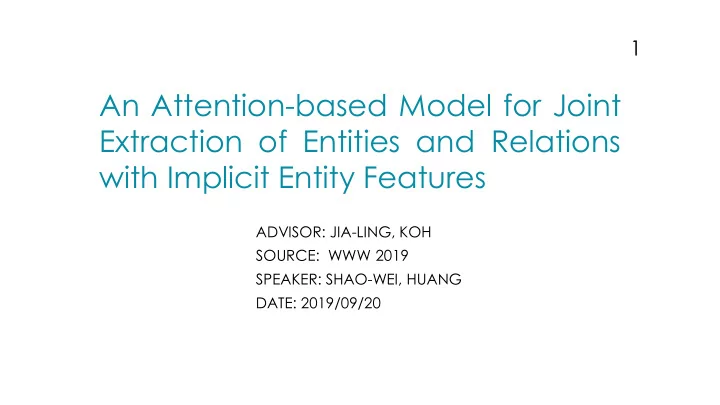

1 An Attention-based Model for Joint Extraction of Entities and Relations with Implicit Entity Features ADVISOR: JIA-LING, KOH SOURCE: WWW 2019 SPEAKER: SHAO-WEI, HUANG DATE: 2019/09/20
2 OUTLINE ⚫ Introduction ⚫ Method ⚫ Experiment ⚫ Conclusion
INTRODUCTION 3 ➢ Extract entities and their semantic relations from an unstructured input sentence. (Ex): ”Donald Trump is the 45th and current president of the United States" (Donald Trump, President-Of, United States) Eentiy 1 Semantic relation Eentiy 2
4 INTRODUCTION Two categories method of RE Two categories method of RE ➢ Pipelined models : ⚫ Identify the entity pair first. And then predict the relations between them. (Donald Trump, United States) (President-Of) Result have an impact on it ➢ Joint models(this paper use) : Identify the entity pair and relations at the same time. ⚫
5 INTRODUCTION Problem definition E : End B : Begin Other PR : President-Of (Have Begin, Inside, End, Single four type) 2 : Second entity PR : President-Of (Predfined 24 relation type) 1 : First entity
6 OUTLINE Introduction Method Experiment Conclusion
7 FRAMEWORK 7
8 METHOD Features(Word embedding & character embedding ) ➢ Word embedding : ⚫ Pre-train the embedding for words. ➢ Character embedding : ⚫ Each word is broken up into individual characters. ⚫ Each characters are mapping to their embedding ( 𝑑 1 , 𝑑 2 , …, 𝑑 𝑀 ). ⚫ Adopt Bi-LSTM to generates the character embedding for the word.
9 9 METHOD Features(Word embedding & character embedding ) Character ➢ Character embedding : embedding for the word ℎ 3 ℎ 4 ℎ 5 ℎ 6 ℎ 1 ℎ 2 Bi- Bi- Bi- Bi- Bi- Bi- LSTM LSTM LSTM LSTM LSTM LSTM Donald a l d o n d
10 METHOD Features(Implicit features) ➢ Implicit entity feature : ⚫ Pre-train an model on an existing NER dataset. ⚫ Feed the input sentence(Danald Trump is the…...) into this model. ⚫ The hidden vectors are entity features.
11 11 METHOD Features(Implicit features) ➢ Implicit entity feature :
12 12 METHOD Encoder layer ➢ LSTM : 𝑢 https://www.itread01.com/content/1545027542.html
13 13 METHOD Encoding layer ➢ Encoding layer : This layer receives three ⚫ vectors(concate) as input. ⚫ Use Bi-LSTM to computes the t step hidden state ℎ 𝑢 .
14 METHOD Attention layer The input of attention layer
15 METHOD Attention layer ➢ Tag aware attention : Attention vector (relevant representation) ⚫ Allow the model to select the relevant parts of the sentence for the prediction of the tag. ⚫
16 16 METHOD Attention layer ➢ Fusion gate : ⚫ When predicting the tag of a word, the gate allows to trade off the information used from ℎ𝑏 𝑢 and ℎ 𝑢 . Weight ⚫ Output of attention layer
17 METHOD Decoding layer The input of decoding layer
18 METHOD Decoding layer ➢ Decoding layer : ⚫ Adopt LSTM to generate vectors representing the output states. t-th t-1-th t-1-th output of hidden state tag Attention layer of LSTM embedding
METHOD Decoding layer 19 ➢ Decoding layer(continue) : ⚫ Adopt a softmax classifier to compute entity tag probabilities. ⚫ Objective function :
20 OUTLINE Introduction Method Experiment Conclusion
21 EXPERIMENT Dataset ➢ NYT : • 353000 triplets in the training data and 3880 triplets in the testing data. • Relation type in the dataset is 24.
EXPERIMENT 22 ➢ Dimension sizes :
EXPERIMENT • A triplet is regarded as correct 23 when all correct. ➢ Comparison with baselines : Pipelined Joint End-to-end
24 EXPERIMENT • A triplet is regarded as correct when all correct. ➢ Ablation results :
EXPERIMENT 25 ➢ Ablation results on triplet elements :
EXPERIMENT 26 ➢ Visualization of attention weights :
27 OUTLINE Introduction Method Experiment Conclusion
28 CONCLUSION ➢ Propose an attention-based model enhanced with implicit entity features for the joint extraction of entities and relations. ➢ This model can take advantage of the entity features and dose not need to manually design them. ➢ Design a Tag-Aware attention mechanism which enables our model to select the informative words to the prediction.
Recommend
More recommend